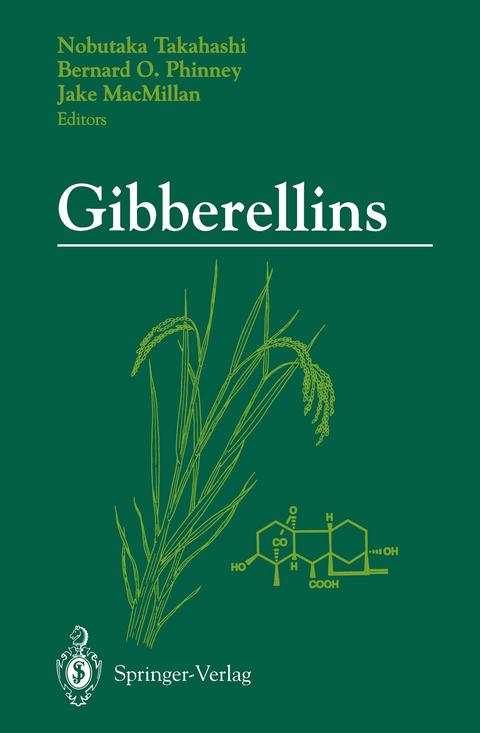
Gibberellins
Springer-Verlag New York Inc.
978-1-4612-7754-5 (ISBN)
1. Historical Aspects of Gibberellins.- I. Organ Specificity and Dwarfism.- 2. Organ-Specific Gibberellins in Rice: Roles and Biosynthesis.- 3. Gibberellin Metabolism in Maize: Tissue Specificity.- 4. Gibberellins from the Tassel, Cob, ‘Seed,’ Silk, and Pollen of Maize.- 5. Gibberellin Mutants in Pisum and Lathyrus.- II. Biosynthetic Enzymes.- 6. The Relationship of Different Gibberellin Biosynthetic Pathways in Cucurbita maxima Endosperm and Embryos and the Purification of a C-20 Oxidase from the Endosperm.- 7. Enzymatic 3?-Hydroxylation of Gibberellins A20 and A5.- 8. Partial Characterization of the Gibberellin 3?-Hydroxylase from Immature Seeds of Phaseolus vulgaris.- 9. Gibberellin Metabolism in Cell-Free Preparations from Phaseolus coccineus.- 10. Gibberellin Biosynthetic Enzymes and the Regulation of Gibberellin Concentration.- III. Molecular Aspects.- 11. Gibberellin A3-Regulated ?-Amylase Synthesis and Calcium Transport in the Endoplasmic Reticulum of Barley Aleurone Cells.- 12. Rice ?-Amylase and Gibberellin Action—A Personal View.- 13. Gibberellin Production and Action During Germination of Wheat.- 14. Probing Gibberellin Receptors in the Avena fatua Aleurone.- 15. A Minireview on the Immunoassay for Gibberellins.- IV. Physiology and Metabolism.- 16. Physiology of Gibberellins in Relation to Floral Initiation and Early Floral Differentiation.- 17. Role of Endogenous Gibberellins During Fruit and Seed Development.- 18. Correlations Between Apparent Rates of ent-Kaurene Biosynthesis and Parameters of Growth and Development in Pisum sativum.- 19. Gibberellins and the Regulation of Shoot Elongation in Woody Plants.- 20. The Gibberellin Control of Cell Elongation.- 21. The role of Gibberellin in the Formation of Onion Bulbs.- 22. Gibberellin Requirementfor the Normal Growth of Roots.- 23. Effects of Gibberellin A3 on Growth and Tropane Alkaloid Synthesis in Ri Transformed Plants of Datura innoxia.- 24. Biochemical and Physiological Aspects of Gibberellin Conjugation.- 25. Metabolism of [3H]Gibberellin A4 and [2H]Gibberellin A4 in Cell Suspension Cultures of Rice, Orygza sativa cv. Nihonbare.- V. Light Effects.- 26. Stem Growth and Gibberellin Metabolism in Spinach in Relation to Photoperiod.- 27. Phytochrome Mediation of Gibberellin Metabolism and Epicotyl Elongation in Cowpea, Vigna sinensis L..- 28. Role of Gibberellins in Phytochrome-Mediated Lettuce Seed Germination.- VI. Growth Retardants.- 29. Inhibitors of Gibberellin Biosynthesis: Applications in Agriculture and Horticulture.- 30. Studies on the Action of the Plant Growth Regulators BX-112, DOCHC, and DOCHC-Et.- 31. Studies on Sites of Action of the Plant Growth Retardant 4?- Chloro-2?-(?-Hydroxybenzyl)isonicotinanilide (Inabenfide) in Gibberellin Biosynthesis.- 32. Effects of the Growth Retardant Uniconazole-P on Endogenous Levels of Hormones in Rice Plants.- 33. Inconsistency Between Growth and Endogenous Levels of Gibberellins, Brassinosteroids, and Sterols in Pisum sativum Treated with Uniconazole Antipodes.- VII. Applied Aspects.- 34. Gibberellin Increases Cropping Efficiency in Sour Cherry (Prunus cerasus L.).- 35. Prospects for Gibberellin Control of Vegetable Production in the Tropics.- 36. Gibberellin-Induced Flowering and Morphological Changes in Taro Plants.- VIII. Antheridiogens.- 37. Antheridiogens of Schizaeaceous Ferns: Structures, Biological Activities, and Biosynthesis.- 38. Antheridiogen, Gibberellin, and the Control of Sex Differentiation in Gametophytes of the Fern Lygodium japonicum.- 39. Synthetic Pathways to Fern Antheridiogensfrom Gibberellins.
| Zusatzinfo | XXI, 426 p. |
|---|---|
| Verlagsort | New York, NY |
| Sprache | englisch |
| Maße | 155 x 235 mm |
| Themenwelt | Naturwissenschaften ► Biologie ► Biochemie |
| Naturwissenschaften ► Biologie ► Genetik / Molekularbiologie | |
| Naturwissenschaften ► Biologie ► Mikrobiologie / Immunologie | |
| Naturwissenschaften ► Biologie ► Zellbiologie | |
| ISBN-10 | 1-4612-7754-X / 146127754X |
| ISBN-13 | 978-1-4612-7754-5 / 9781461277545 |
| Zustand | Neuware |
| Haben Sie eine Frage zum Produkt? |
aus dem Bereich


